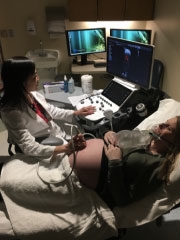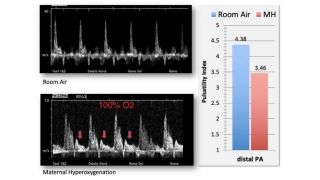Maternal Hyperoxygenation Testing During Fetal Echocardiography
A New Window of Insight Into the Fetal Cardiovascular System
Published on
In Utero InsightsPublished on
In Utero Insights Figure 1: Patient receiving maternal hyperoxygenation as part of fetal echocardiography protocol.
Standard fetal echocardiography allows for accurate characterization of the state of fetal cardiovascular anatomy and physiology through two dimensional imaging and Doppler ultrasound. Predicting postnatal physiology once the lungs are now incorporated into the circuit can often be a challenge.
Figure 1: Patient receiving maternal hyperoxygenation as part of fetal echocardiography protocol.
Standard fetal echocardiography allows for accurate characterization of the state of fetal cardiovascular anatomy and physiology through two dimensional imaging and Doppler ultrasound. Predicting postnatal physiology once the lungs are now incorporated into the circuit can often be a challenge.
Cardiopulmonary (heart-lung) interactions play an important role in the pathophysiology of many different types of congenital heart lesions. Having the capacity to assess the pulmonary vasculature and to potentially alter prenatal flow by altering fetal vascular bed resistances in a safe and reliable manner would be of tremendous value.
The Fetal Heart Program at CHOP is one of the first programs in the world to begin incorporating provocative testing with maternal hyperoxygenation in our fetal echocardiography imaging suite. Maternal hyperoxygenation (MH) testing allows us the best chance to predict the health of the pulmonary vasculature before birth.
 Figure 2: Doppler spectral display of blood flow in the right pulmonary artery under room air (top panel) and under conditions of 15 minutes of maternal hyperoxygenation (bottom panel).
In the late third trimester, a scan is first performed in room air and then repeated after at least 15 minutes of MH, in which the mother is administered a non-rebreather face mask with 100% oxygen at 8L of flow. This effectively provides an FiO2 of 60%. With Doppler echocardiography, sampling of flow can take place at various sites within the circulation. Normal baseline tracings are compared to the response in MH. Normal and abnormal responses to MH are determined, and this information is added to supplement the characterization of the fetal cardiovascular condition.
Figure 2: Doppler spectral display of blood flow in the right pulmonary artery under room air (top panel) and under conditions of 15 minutes of maternal hyperoxygenation (bottom panel).
In the late third trimester, a scan is first performed in room air and then repeated after at least 15 minutes of MH, in which the mother is administered a non-rebreather face mask with 100% oxygen at 8L of flow. This effectively provides an FiO2 of 60%. With Doppler echocardiography, sampling of flow can take place at various sites within the circulation. Normal baseline tracings are compared to the response in MH. Normal and abnormal responses to MH are determined, and this information is added to supplement the characterization of the fetal cardiovascular condition.
See Figure 2: In room air, note the appearance of the systolic waveform with rapid upstroke and downstroke, with minimal flow during diastole. This indicates a high pulmonary vascular resistance. With maternal hyperoxygenation, there is a “relaxation” of the vasculature with pulmonary vasodilation. This is exhibited by the broadening of the systolic waveform and a substantial increase in diastolic flow, previously not seen (red arrows). This response to MH can be quantified by a drop in the calculated pulsatility index as seen in the above graph.
This technique has been used extensively in hypoplastic left heart syndrome (HLHS), in order to understand the impact of a restrictive or intact atrial septum. In utero, a restrictive or intact atrial septum may lead to maladaptive changes within the pulmonary vasculature, characterized by “arteriolization” of the pulmonary veins and dilation of the lymphatics. At birth, these neonates can have profound disturbances in ventilation and oxygenation.
Despite aggressive interventions to open up the atrial septum in the cardiac catheterization lab immediately after birth, postnatal survival rates for fetuses with HLHS with a restrictive or intact atrial septum remain significantly lower than for HLHS fetuses without this risk factor. Consequently, a tool to assess the integrity of the pulmonary vasculature before birth allows us to plan for an immediate intervention after birth via a scheduled delivery to ensure the highest chance for postnatal survival.
MH can potentially play an important role in other fetal heart conditions besides HLHS. Vasodilation of vascular circuits can lead to redistribution of blood flow to various heart chambers. MH may prove to be of great value in assessing the pulmonary vasculature and foramen ovale in transposition of the great arteries and in the borderline size left ventricle in determining the possible presence of a coarctation of the aorta.
To date, we have administered MH testing to more than 200 mothers with no deleterious side effects. The utility of this method of provocative testing is being evaluated as it has the potential to tremendously enrich the diagnostic information we collect as we evaluate fetuses with cardiovascular disease.
Contributed by: Anita L. Szwast, MD
Categories: Fetal Heart Program